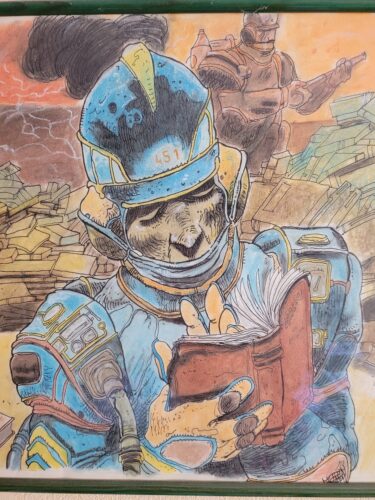AAC/ CFP : Star
Trek, dynamiques
d’une fabrique de mondes : expansion, variation, densification / Star
Trek, Dynamics of a World-Building Factory : Expansion, Variation,
Densification (Paris)
https://startrekparis2026.wordpress.com/
[English version
will follow.]
Depuis les soixante ans qui nous sépareront bientôt de sa première
diffusion le 8 septembre 1966, Star Trek s’est imposé comme un
univers de fiction proliférant, transmédiatique et intergénérationnel que l’on
peut diviser en trois grandes ères. La première est celle des débuts hésitants
de la première série télévisée, dénommée désormais Star Trek: The
Original Series (1966-1969) et de sa continuation animée (1973-1974).
La deuxième, amorcée dès 1979 par la sortie au grand écran de Star
Trek: The Motion Picture, s’est poursuivi au cinéma (9 films entre 1982 et
2002) et dans de nombreuses séries télévisées dérivées : The Next
Generation (1987-1994), Deep Space Nine (1993-1999), Voyager (1995-2001)
et Enterprise (2001-2005). La troisième ère, encore en cours,
débute également au cinéma en 2009 par un reboot de la franchise au gré d’une
trilogie lancée par J.J. Abrams qui s’est conclue en 2016. Depuis, c’est la
continuité initiale du monde fictionnel qui est développée par des préquelles
et suites télévisuelles sur les plateformes de vidéos à la demande
(SVoD) : Discovery (2017-2024), Picard (2020-2023), Strange
New World (2022-), sans compter les séries d’animation et un téléfilm.
À ces œuvres audiovisuelles, il faut ajouter de nombreux romans, bandes
dessinées, fanfictions et jeux vidéo.
Au fil des années et à travers les médias, l’ambition de la franchise est
restée la même : décrire un futur relativement proche (XXIIe à XXVe siècles, avec une incursion plus
récente au XXXIIe siècle), imaginé
par son créateur, Gene Roddenberry, comme une utopie, quoiqu’elle a pu proposer
à l’occasion des moments plus sombres ou pessimistes. Dans Star Trek,
l’humanité a su surmonter les obstacles politiques, écologiques et moraux du
XXIe siècle pour
atteindre les étoiles et participer à la création de la Fédération des Planètes
Unies, rassemblant de nombreuses civilisations extraterrestres à travers la
galaxie, séparée en quatre immenses quadrants.
Évidemment, si cette série de science-fiction utopique est née dans les
années 1960, ce n’est sans doute pas un hasard. La première version, qui
apparaît alors que la course à l’espace et la révolution sexuelle éveillent les
imaginations, peut également être vue comme un reflet critique des tensions de
la guerre froide et des débats de société états-uniens dans les années 1960,
notamment les luttes pour les droits civiques. Il faut dire que la présence
d’acteurs russe et japonais et d’une actrice afro-américaine pour interpréter
certains des officiers sur le pont du USS Enterprise n’est pas passée
inaperçue, tout comme le premier baiser à transcender les tabous raciaux de la
télévision américaine de l'époque. Mais le relatif progressisme (plusieurs ont
pointé ses limites depuis) de Star Trek n’était pas que dans
la production, il alimentait également les scénarios qui proposaient chaque
semaine une nouvelle planète et ses habitants, une planète qui élargissait le
monde fictionnel toujours en expansion et qui permettait d’aborder différents
enjeux politiques ou culturels par analogie. On note ainsi que l’expansion est
une dynamique structurante de la franchise dès ses origines. Cette volonté se
prolonge d’ailleurs aujourd’hui : chaque époque a sa version de Star Trek
qui aborde ses problèmes spécifiques ou plus universels. The Next
Generation apparaît alors que Ronald Reagan est au pouvoir et
déconstruit certains des acquis des luttes sociales des années 1960; Voyager propose
un personnage de femme capitaine forte, mais conservatrice et parfois assez
autoritaire, alors que le féminisme subit des contrecoups; Discovery s’intéresse
aux enjeux de la diversité sexuelle (orientation sexuelle et genre); Picard aborde
la question des réfugiés environnementaux et l’intelligence artificielle, etc.
Ce n’est donc pas surprenant si, depuis les années 1990, Star
Trek est devenu un objet d’étude privilégié dans les cultural studies
anglo-saxonnes, dans les études sur les médias populaires et sur la
science-fiction, mais ces études demeurent très rares du côté francophone. La
plupart des travaux sont centrés sur ses dimensions idéologiques, politiques et
sociales. Mentionnons l’apparition très tôt d’analyses des représentations
raciales (Bernardi 1998, Kilgore 2003, Mittermeier and Spychala 2020), de
lectures sociopolitiques plus larges (Reagin 2013, Booker 2018), de travaux sur
le genre (Farghali et Bacon 2017, Mittermeier and Spychala 2020, Millsap-Spears
2024) ou sur la diplomatie galactique (Gonzalez 2015).
Pourtant, si l’univers Star Trek a suscité une quantité
impressionnante d’analyses critiques, peu de travaux prennent pour objet
principal la construction de son monde fictionnel en tant que telle — sa
logique interne, sa narrativité transmédiatique, sa plasticité ontologique.
L’exception notable est le champ des fan studies qui examine comment les
communautés de fans participent à l’expansion, la critique ou la réécriture du
canon (Jenkins 1992, Falzone 2005, Drushel 2013), mais sans toujours en
articuler les implications esthétiques ou narratives. Pourtant, dès ses
débuts, Star Trek est envisagé par certains, comme Michael
Moorcock (1968), comme un véritable tournant pour la fiction et la narration,
inaugurant une exigence nouvelle de diversité narrative, d’engagement social
avec les spectateurs et de franchissement des frontières de genre, intégrant
une interpénétration des textes savants avec des formes populaires.
Il semble donc aujourd’hui nécessaire d’interroger Star Trek sous
l’angle de ses pratiques narratives, esthétiques et mythopoétiques (Kapell
2010), en recentrant l’attention sur les modalités de sa construction
fictionnelle. Loin de rejeter les approches politiques et culturelles qui ont
dominé la recherche sur Star Trek, ce colloque entend les prolonger
dans une autre direction, en interrogeant ce que signifie « fabriquer des
mondes » dans et autour de Star Trek. Le présent colloque, qui
célèbre les 60 ans de la franchise, souhaite ainsi déplacer le regard vers
le worldbuilding de Star Trek, entendu non comme
un arrière-plan figé, mais comme un processus dynamique, un système en
expansion, parfois en contradiction, toujours en transformation. Cet univers,
qui articule continuités et ruptures à travers ses nombreuses itérations, offre
un terrain privilégié pour penser la création d’univers cohérents dans leur
plasticité même, ainsi que les tensions entre continuité, divergence et
reprise; utopie, dystopie et uchronie; récit, imaginaire et encyclopédisme.
Par ailleurs, la dimension encyclopédique de l’univers de Star Trek est
parfois si patente qu’elle a alimenté la publication d’ouvrages qui traitent
son matériau fictionnel – envisagé comme un « bien expressif »
(Kavanagh et al 2001) – comme le feraient de véritables encyclopédies
(Ruditis 2013). Et c’est sans compter le megatext science fictionnel (Broderick
1995) et la xénoencyclopédie (Saint-Gelais 1999) qu’il a largement contribué à
construire et à alimenter : vaisseaux spatiaux, téléporteurs, communicateurs
et scanners, traducteurs universels, androïdes, fédération de planètes,
directive première et protocole de premier contact, etc. Les exemples de novums
qui ont construit le monde fictionnel de Star Trek avant de
devenir des éléments incontournables de tout space opera abondent.
Dans le cadre de ce colloque, nous vous invitons à réfléchir à la fabrique
de l’univers de Star Trek, bien plus vaste qu’un simple monde
possible, selon une pluralité d’approches : narratologique, esthétique,
sémiotique, intertextuelle, médiologique ou anthropologique. Il pourra
notamment s’agir de questionner :
- les modalités du récit dans Star Trek :
formes sérielles, transmédiatiques, épisodes expérimentaux, dispositifs
d’embrayage ou de reconfiguration du monde diégétique;
- les tensions entre cohérence et contradiction
dans l’univers étendu (continuité, retcon, paradoxes temporels, mondes
parallèles);
- les dimensions esthétiques des mondes Star
Trek : architecture, design, modes de corporéité, rapports aux
technologies;
l’invention de langues comme le klingon (Lecercle 2015) comme poétique de
l’altérité ou le traducteur universel comme politique de l’universalisme; - l’exploration spatiale, le voyage temporel et le
monde virtuel (holodeck/holosuite) comme modes d’expansion
fictionnelle;
l’utilisation des mécanismes de l’Histoire humaine et de la mythologie
dans la création par analogie de mondes, de peuples et de planètes; - les réemplois, détournements intertextuels
(science-fiction « classique », tragédie shakespearienne,
figures du roman policier ou du roman maritime, mais aussi productions
dérivées, pastiches [The Orville, Galaxy Quest, Dans
une galaxie près de chez vous, etc.], hommages, parodies ou fanfictions);
- les interactions entre texte officiel et
productions faniques (fanlore, slash fiction, encyclopédies
communautaires) comme autant de reconfigurations du monde partagé.
Ce colloque propose donc de rejoindre les débats actuels sur la
narratologie transmédiale (Baroni 2017) et sérielle (Letourneux 2017, Favard
2018, Machinal 2020), sur la fiction spéculative (Forêt et Yulmuk-Bray 2024,
Stengers 2020 et 2000), la poétique du mythe et la construction contemporaine
des mondes imaginaires (Kapell 2010, Besson 2015). Il s’agit ainsi de penser
Star Trek non seulement comme un miroir critique du monde, mais aussi comme une
machine fictionnelle et narrative, autoréflexive, en expansion constante, qui
pose des questions fondamentales sur la narration (du point de vue de sa
création comme de sa réception), la cohérence, la norme et l’altérité.
Le colloque aura lieu du jeudi 17 au samedi 19 septembre 2026 au
Collège britannique à la Cité internationale à Paris. Les propositions de
communication (25 min) d’un maximum de 350 mots, accompagnées d’une
courte notice bio-bibliographique, sont à envoyer avant le 15 janvier
2026 à l’adresse suivante : startrekparis2026@gmail.com. Les
communications pourront être en français ou en anglais.
Comité d’organisation : Elaine Després (Université du Québec à
Montréal), Florent Favard (Université de Lorraine, CREM), Anaïs Guilet
(Université Savoie Mont Blanc, Laboratoire LLSETI), Hélène Machinal (Université
Rennes 2, ACE) et Jessy Neau (Université de Poitiers, FoReLLIS).
Bibliographie
- Baroni, Raphaël. (2017). « Pour une
narratologie transmédiale ». Poétique, no 182 (2), pp.
155-175.
- Bernardi,
Daniel. (1998). Star Trek and History: Race-Ing toward a White
Future. New
Brunswick : Rutgers UP.
- Besson, Anne (2015). Constellations. Des
mondes fictionnels dans l’imaginaire contemporain. Paris : CNRS
edition.
- Booker,
M. Keith (2018). Star Trek: A Cultural History. New York : Rowman & Littlefield.
- Broderick,
Damien (1995). Reading by Starlight: Postmodern Science Fiction.
New York : Routledge.
- Després, Elaine (2020). « La sentience des
androïdes : de Star Trek à Westworld ». Dans J.-F. Chassay et I.
Boof-Vermesse (dir.), L’âge des postmachines, Montréal :
PUM, pp. 73-92.
- Després, Elaine (2019), « Voyage (impromptu
et déroutant) au bout de l’univers », Otrante, art et
littérature fantastique, no 46, automne, pp. 13-33.
- Drushel,
Bruce E. (dir.) (2013). Fan Phenomena: Star Trek.
Bristol : Intellect Books.
- Falzone,
Paul J. (2005). « The Final Frontier Is Queer: Aberrancy,
Archetype and Audience Generated Folklore in K/S
Slashfiction ». Western
Folklore,
été-automne, vol. 64, no 3/4, pp. 243-261. https://www.jstor.org/stable/25474751.
- Farghali, Nadine et Bacon, Simon (2017). To
Boldly Go. Essays on Gender and Identity in the Star Trek Universe. Jefferson : McFarland.
- Favard, Florent (2018). Le récit dans les
séries de science-fiction. De Star Trek à X-Files. Paris : Armand
Colin.
- Favard, Florent et Hélène Machinal (dir.) (2019).
« La sérialité en question ». TV/series, no 13.
- Favard, Florent et Hélène Machinal (dir.) (2022).
« Séries télévisées de science-fiction ». Res Futurae,
no 19.
- Forêt, Marceau et Yulmuk-Bray, Ketzali (2024).
« Nouvelle alliance entre science et fiction ». Revue
critique de fixxion française contemporaine, no 28. https://doi.org/10.4000/11u01
- Gonzalez,
Georges A. (2015). The Politics of Star Trek. Justice, War, and
the Future. New
York : Palgrave MacMillan.
- Jenkins,
Henry (2006). Convergence Culture: Where Old and New Media Collide.
New York : New York
University Press.
- Jenkins,
Henry (1992). Textual Poachers: Television Fans and Participatory
Culture. New
York : Routledge.
- Kapell,
Matthew Wilhelm (dir.) (2010). Star Trek as Myth: Essays on Symbol
and Archetype at the Final Frontier. Jefferson : McFarland.
- Kilgore,
De Witt Douglas (2003). Astrofuturism: Science, Race, and Visions
of Utopia in Space. Philadelphie :
University of Pennsylvania Press.
- Lecercle, Jean-Jacques (2015).
« Bleghbe’chugh vaj blHegh! From an Ethics of
Alterity to a Politics of Style ». Dans M. Rospide et S. Sorlin (dir.), The
Ethics of Alterity : New perspectives on Genre Literature,
Cambridge Publishers, pp. 14-32.
- Letourneux, Matthieu (2017). Fictions à
la chaîne. Paris : Seuil, coll. « Poétique ».
- Machinal, Hélène (2020). Posthumains en
série. Tours : Presses universitaires François-Rabelais.
- Millsap-Spears,
Carey (2024). Star Trek Discovery and the Female Gothic. Lanham : Lexington Books.
- Mittell,
Jason (2015). Complex TV: The Poetics of Contemporary Television
Storytelling. New
York: NYU Press.
- Mittermeier, Sabrina et Garcia-Siino, Leimar
(dir.) (2022). The Routledge Handbook of Star
Trek. New
York : Routledge.
- Mittermeier, Sabrina et Spychala, Mareile (dir.) (2020). Fighting
for the Future – Essays on Star Trek: Discovery. Liverpool : Liverpool University Press.
- Neau, Jessy (2024). « Star Trek : The
Next Generation (1987-1994) ; un procès caché de l’humanité en sept
saisons », TV/Series, no 23. https://doi.org/10.4000/12lhs
- Reagin,
Nancy (2013). Star Trek and History. Hoboken : Wiley.
- Ruditis,
Paul (2013). Star Trek: The Visual Dictionary: The Ultimate Guide
to Characters, Aliens, and Technology. Londres : DK.
- Saint-Gelais, Richard (1999). L’empire du
pseudo. Modernités de la science-fiction. Québec : Nota Bene.
- Stengers, Isabelle (2020). « Ursula Le
Guin-Penser en mode SF ». Épistémocritique, hors
série, https://epistemocritique.org/ursula-le-guin-penser-en-mode-sf/
- Stengers, Isabelle (2000). « Science-fiction
et expérimentation ». Dans Philosophie et science-fiction,
Bruxelles: Vrin.
********************************************
Star Trek, Dynamics of a World-Building Factory :
Expansion, Variation, Densification
Call for papers - International conference
Since its first broadcast on
September 8, 1966, Star Trek has established itself as a
prolific, transmedia, and intergenerational fictional universe that can be
divided into three major eras. The first is that of the tentative beginnings of
the first television series, now known as Star Trek: The Original
Series (1966-1969), and its animated continuation (1973-1974). The
second era began in 1979 with the release of Star Trek: The Motion Picture and
continued with nine films between 1982 and 2002, as well as numerous spin-off
television series: The Next Generation (1987-1994), Deep
Space Nine (1993-1999), Voyager (1995-2001) and Enterprise (2001-2005).
The third era, which is still ongoing, also began in the cinema in 2009 with a
reboot of the franchise in the form of a trilogy launched by J.J. Abrams, which
concluded in 2016. Since then, the initial continuity of the fictional world
has been developed through prequels and sequels on video-on-demand (SVoD)
platforms: Discovery (2017-2024), Picard (2020-2023), Strange
New World (2022-), not to mention animated series and a TV movie. In
addition to these audiovisual works, there are numerous novels, comic books,
fan fiction, and video games.
Over the years and across
media platforms, the franchise's ambition has remained the same: to depict a
relatively near future (from the 22nd to 25th centuries, with a more recent
foray into the 32nd century), imagined by its creator, Gene Roddenberry, as a
utopia, even though it has occasionally offered darker or more pessimistic
moments. In Star Trek, humanity has overcome the political, ecological, and
moral obstacles of the 21st century to reach for the stars and participate in
the creation of the United Federation of Planets, bringing together numerous
alien civilizations across the galaxy, divided into four immense quadrants.
Of course, it is probably no
coincidence that this utopian science fiction series was created in the 1960s.
The first version, which appeared at a time when the space race and the sexual
revolution were capturing people's imaginations, can also be seen as a critical
reflection of the tensions of the Cold War and the social debates in the United
States in the 1960s, particularly the civil rights movements. Obviously, the
presence of Russian, Japanese, and African-American actors playing some of the
officers on the bridge of the USS Enterprise did not go unnoticed, nor did the
first interracial kiss on American television. But Star Trek's
relative progressiveness (it has since been nuanced by many) was not limited to
the production; it also fueled the scripts, which each week presented a new
planet and its inhabitants, a planet that expanded the ever-growing fictional
world and allowed different political and cultural issues to be addressed by
analogy. It is clear that expansion has been a defining dynamic of the
franchise since its inception. This desire continues today: each era has its
own version of Star Trek that addresses its specific or more
universal problems. The Next Generation appeared while Ronald
Reagan was in power and dismantled some of the gains made by the social
struggles of the 1960s. Voyager introduced a strong female
captain, yet she was also quite conservative and sometimes even authoritarian,
but the context was that of a feminist backlash. Discovery focuses
on issues of sexual diversity (sexual orientation and gender); Picard addresses
the issue of environmental refugees and artificial intelligence, etc.
It is therefore not surprising
that, since the 1990s, Star Trek has become a favored subject
of study in Anglo-Saxon cultural studies, popular media studies, and science
fiction studies, but such studies remain very rare in the French-speaking
world. Most of the work focuses on its ideological, political, and social
dimensions. Noteworthy are the early analyses of racial representations
(Bernardi 1998, Kilgore 2003, Mittermeier and Spychala 2020), broader
sociopolitical readings (Reagin 2013, Booker 2018), works on gender (Farghali
and Bacon 2017, Mittermeier and Spychala 2020, Millsap-Spears 2024) and
galactic diplomacy (Gonzalez 2015).
However, while the Star
Trek universe has been the subject of an impressive amount of critical
analysis, few works focus primarily on the construction of its fictional world
as such—its internal logic, transmedia narrativity, and ontological plasticity.
The notable exception is the field of fan studies, which examines how fan
communities participate in the expansion, critique, or rewriting of the canon
(Jenkins 1992, Falzone 2005, Drushel 2013), but without always articulating the
aesthetic or narrative implications. Yet, from its inception, Star Trek has
been viewed by some, such as Michael Moorcock (1968), as a true turning point
for fiction and storytelling, ushering in a new demand for narrative diversity,
social engagement with viewers, and the crossing of genre boundaries,
integrating an interpenetration of scholarly texts with popular forms.
It therefore seems necessary
today to examine Star Trek from the perspective of its
narrative, aesthetic, and mythopoetic practices (Kapell 2010), refocusing
attention on the modalities of its fictional construction. Far from rejecting
the political and cultural approaches that have dominated research on Star
Trek, this conference aims to extend them in another direction, by questioning
what it means to “make worlds” in, around or from Star Trek. This
conference, which celebrates the franchise's 60th anniversary, thus seeks to
shift the focus to the worldbuilding of Star Trek, understood not
as a fixed backdrop, but as a dynamic process, an expanding system, sometimes
contradictory, always in transformation. This universe, which articulates
continuities and ruptures through its many iterations, offers a privileged
terrain for thinking about the creation of universes that are coherent in their
very plasticity, as well as the tensions between continuity, divergence, and
revival; utopia, dystopia, and uchronia; narrative, imagination, and
encyclopedism.
Furthermore, the encyclopedic
dimension of the Star Trek universe is sometimes so obvious
that it has fueled the publication of works that treat its fictional
material—considered an “expressive good” (Kavanagh et al 2001)—as real
encyclopedias would (Ruditis 2013). And that's not to mention the science
fiction megatext (Broderick 1995) and the xenoencyclopedia (Saint-Gelais 1999)
that it has largely contributed to building and feeding: spaceships,
teleporters, communicators and scanners, universal translators, androids,
federation of planets, prime directive and first contact protocol, etc. There
are countless examples of novums that built the fictional world of Star
Trek before becoming essential elements of any space opera.
As part of this symposium, we
invite you to reflect on the construction of the Star Trek universe,
which is much broader than a simple possible world, using a variety of
approaches: narratological, aesthetic, semiotic, intertextual, mediological, or
anthropological. This may involve questioning:
- the
narrative modalities in Star Trek: serial forms, transmedia
forms, experimental episodes, devices for linking or reconfiguring the
diegetic world;
- the
tensions between coherence and contradiction in the extended universe
(continuity, retcon, temporal paradoxes, parallel worlds);
- the
invention of languages such as Klingon (Lecercle 2015) as a poetics of
otherness, or the universal translator as a politics of universalism;
space exploration, time travel, and the virtual world (holodeck/holosuite)
as modes of fictional expansion; - the use
of mechanisms from human history and mythology in the creation, by
analogy, of worlds, peoples, and planets;
- reuse
and intertextual appropriation (classic science fiction, Shakespearean
tragedy, characters from detective novels or maritime novels, but also
derivative works, pastiches [The Orville, Galaxy Quest, Dans
une galaxie près de chez vous, etc.], tributes, parodies, and fan
fictions);
- the
interactions between official texts and fan productions (fanlore, slash
fiction, community encyclopedias) as reconfigurations of the shared world.
This symposium therefore aims
to join the current debates on transmedia (Baroni 2017) and seriality (Mittell
2015, Letourneux 2017, Favard 2018, Machinal 2020) narratology, speculative
fiction (Forêt and Yulmuk-Bray 2024, Stengers 2020 and 2000), the poetics of
myth, and the contemporary construction of imaginary worlds (Kapell 2010,
Besson 2015). The aim is therefore to think of Star Trek not
only as a critical mirror of the world, but also as a fictional and narrative
machine, self-reflexive and constantly expanding, which raises fundamental
questions about narration (from the point of view of both its creation and its
reception), coherence, norms, and otherness.
The conference will take place
from Thursday, September 17 to Saturday, September 19, 2026, at the
British College at the Cité internationale in Paris. Proposals for papers
(25 min) of no more than 350 words, accompanied by a short
bio-bibliographical note, should be sent before January 15, 2026,
to the following address: startrekparis2026@gmail.com. Papers may be in French or English.
Organizing committee: Elaine
Després (University of Quebec in Montreal), Florent Favard (University of
Lorraine, CREM), Anaïs Guilet (University of Savoie Mont Blanc, LLSETI
Laboratory), Hélène Machinal (University of Rennes 2, ACE) and Jessy Neau
(University of Poitiers, FoReLLIS).
Bibliography
- Baroni, Raphaël. (2017). “Pour une narratologie
transmédiale”. Poétique, no 182 (2), pp. 155-175.
- Bernardi,
Daniel. (1998). Star Trek and History : Race-Ing toward a
White Future. New
Brunswick: Rutgers UP.
- Besson, Anne (2015). Constellations. Des
mondes fictionnels dans l’imaginaire contemporain. Paris: CNRS
edition.
- Booker,
M. Keith (2018). Star Trek: A Cultural History. New York: Rowman & Littlefield.
- Broderick,
Damien (1995). Reading by Starlight: Postmodern Science Fiction.
New York: Routledge.
- Després, Elaine (2020). “La sentience des
androïdes : de Star Trek à Westworld”. In J.-F. Chassay and I.
Boof-Vermesse (eds), L’âge des postmachines, Montréal: PUM,
pp. 73-92.
- Després, Elaine (2019), “Voyage (impromptu et
déroutant) au bout de l’univers”. Otrante, art et littérature
fantastique, no 46, automne, pp. 13-33.
- Drushel, Bruce E. (ed) (2013). Fan
Phenomena: Star Trek, Bristol: Intellect Books.
- Falzone, Paul J. (2005). “The Final
Frontier Is Queer: Aberrancy, Archetype and Audience Generated Folklore in
K/S Slashfiction”. Western Folklore, summer-fall, vol. 64, no
3/4, pp. 243-261. https://www.jstor.org/stable/25474751.
- Farghali, Nadine and Bacon, Simon (2017). To
Boldly Go. Essays on Gender and Identity in the Star Trek Universe.
Jefferson: McFarland.
- Favard, Florent (2018). Le récit dans les
séries de science-fiction. De Star Trek à X-Files. Paris: Armand
Colin.
- Favard, Florent et Hélène Machinal (dir.) (2019).
“La sérialité en question”. TV/series, no 13.
- Favard, Florent et Hélène Machinal (dir.) (2022).
“Séries télévisées de science-fiction”. Res Futurae, no 19.
- Forêt, Marceau et Yulmuk-Bray, Ketzali (2024).
“Nouvelle alliance entre science et fiction”. Revue critique de
fixxion française contemporaine, no 28. https://doi.org/10.4000/11u01
- Gonzalez, Georges A. (2015). The Politics
of Star Trek. Justice, War, and the Future. New York: Palgrave
MacMillan.
- Jenkins, Henry (2006). Convergence
Culture: Where Old and New Media Collide. New York: New York
University Press.
- Jenkins, Henry (1992). Textual Poachers:
Television Fans and Participatory Culture. New York: Routledge.
- Kapell, Matthew Wilhelm (ed) (2010), Star
Trek as Myth: Essays on Symbol and Archetype at the Final Frontier.
Jefferson: McFarland.
- Kilgore, De Witt Douglas (2003). Astrofuturism:
Science, Race, and Visions of Utopia in Space. Philadelphia:
University of Pennsylvania Press.
- Lecercle, Jean-Jacques (2015). “Bleghbe’chugh vaj
blHegh! From an Ethics of Alterity to a Politics of Style”. In M. Rospide
and S. Sorlin (eds), The Ethics of Alterity : New
perspectives on Genre Literature, Cambridge: Cambridge Publishers, pp.
14-32.
- Letourneux, Matthieu (2017). Fictions à
la chaîne. Paris: Seuil.
- Machinal, Hélène (2020). Posthumains en
série. Tours: Presses universitaires François-Rabelais.
- Millsap-Spears, Carey (2024). Star Trek
Discovery and the Female Gothic. Lanham: Lexington Books.
- Mittell, Jason (2015). Complex TV: The
Poetics of Contemporary Television Storytelling. New York: NYU Press.
- Mittermeier, Sabrina and Garcia-Siino, Leimar
(eds) (2022). The Routledge Handbook of Star Trek. New York:
Routledge.
- Mittermeier, Sabrina and Spychala, Mareile (eds)
(2020). Fighting for the Future – Essays on Star Trek: Discovery.
Liverpool: Liverpool University Press.
- Neau, Jessy (2024). “Star Trek: The Next
Generation (1987-1994) : un procès caché de l’humanité en sept
saisons”, TV/Series, no 23. https://doi.org/10.4000/12lhs
- Reagin,
Nancy (2013). Star Trek and History. Hoboken: Wiley.
- Ruditis,
Paul (2013). Star Trek: The Visual Dictionary: The Ultimate Guide
to Characters, Aliens, and Technology. London: DK.
- Saint-Gelais, Richard (1999). L’empire du
pseudo. Modernités de la science-fiction. Québec: Nota Bene.
- Stengers, Isabelle (2020). “Ursula Le Guin-Penser
en mode SF”. Épistémocritique, hors série, https://epistemocritique.org/ursula-le-guin-penser-en-mode-sf/
- Stengers, Isabelle (2000). “Science-fiction et
expérimentation”. In Philosophie et science-fiction,
Bruxelles: Vrin.
https://startrekparis2026.wordpress.com/



 Catégorie :
Catégorie : 









